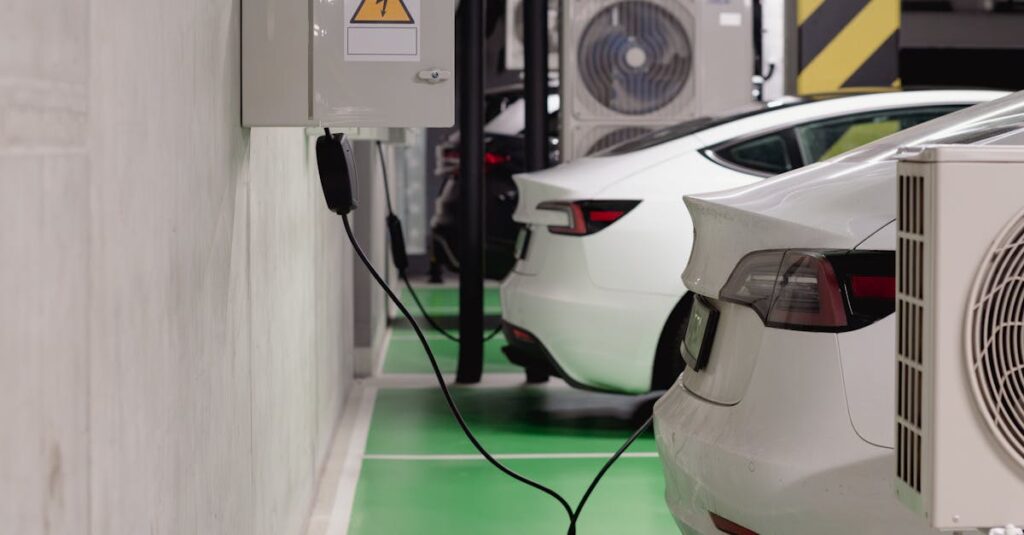Imagine cruising down the street in your shiny new electric vehicle, feeling all eco-friendly and futuristic. But wait—what if you don’t have a garage to plug it in? Panic not! Charging an EV without a garage might sound like trying to find Wi-Fi in the middle of a desert, but it’s totally doable.
Understanding EV Charging Options
Several charging options exist for electric vehicle (EV) owners without garages. Understanding these options is essential for seamless charging experiences.
Home Charging Solutions
Level 1 chargers connect directly to standard household outlets. They work well for those with access to outdoor outlets. Level 2 chargers require a dedicated electrical circuit and provide faster charging. EV owners can install these chargers in driveways or parking spaces, provided they follow local regulations. Using multiple extension cords isn’t recommended due to safety concerns.
Public Charging Stations
Public charging stations offer a practical alternative. Many municipalities and shopping centers provide them, allowing EV owners to charge during errands. Fast chargers significantly reduce charging time, making stops efficient. Apps like PlugShare and ChargePoint help locate nearby stations. Fees vary per station, with some public options being free. Understanding the network of available stations empowers EV owners to strategize charging during longer trips.
Charging at Workplaces
Charging EVs at workplaces offers a convenient solution for those without garages. Many companies provide charging stations, which allow employees to charge during the workday. Accessing these facilities often depends on the employer’s commitment to sustainability.
Employees should inquire about charging resources at their workplace. Understanding the charging capacity available can help plan trips more effectively. Some workplaces feature Level 2 chargers, which provide quicker charging times compared to standard outlets.
Using workplace chargers not only benefits employees but reinforces the company’s eco-friendly initiatives. Companies could also consider installing more charging stations, making it easier for employees to adopt electric vehicles.
In addition, apps like PlugShare and ChargePoint can help locate nearby workplace chargers. Checking these apps ensures access to charging stations during office hours or at commuting times. Familiarizing oneself with these tools enhances the overall charging experience.
As workplaces become more EV-friendly, employees might enjoy perks for using these facilities. Some employers may offer incentives or subsidies, which can further encourage the transition to electric vehicles.
Conclusively, taking advantage of workplace charging stations enhances convenience. While the initial setup may vary, the long-term benefits contribute to a more sustainable commuting option.
Level 1 vs Level 2 Charging
Understanding Level 1 and Level 2 charging options helps EV owners make informed decisions about their charging needs. Both levels offer distinct features catering to different situations.
Differences and Advantages
Level 1 charging connects to standard household outlets, providing convenience in home environments. Charging times generally reach 4 to 5 miles of range per hour. It’s suitable for those with ample time to charge overnight. In contrast, Level 2 charging units require dedicated circuits and deliver 10 to 60 miles of range per hour. Ideal for higher efficiency, this option suits individuals needing quicker turnaround times. Public charging stations often feature Level 2 chargers, making them a practical choice during errands or longer trips. Knowing these differences allows EV owners to select the charging method fitting their lifestyle best.
Costs and Installation
Installation costs for Level 1 chargers are low, averaging around $300, as they utilize existing outlets. No major electrical work is necessary, making them an accessible choice for many homeowners. Level 2 chargers, however, can range from $500 to $2,500, including installation. Installation often requires hiring an electrician, especially for electrical panel upgrades. Long-term, Level 2 chargers save time and enhance usability through faster charging speeds. Weighing upfront costs against efficiency gains helps individuals determine the right option for their situation.
Mobile Charging Solutions
Exploring mobile charging solutions offers convenience for EV owners without garages. Charging your vehicle while on the move can transform the experience. Portable chargers represent one option, enabling users to plug into standard outlets in various locations. These devices often vary in size and design, making them easy to store in a trunk or under a seat.
Another viable option includes using public charging stations, found in shopping centers and along highways. Municipalities increasingly invest in EV infrastructure, improving access to charging resources. Fast chargers significantly reduce downtime, charging vehicles rapidly during short stops. Specific apps such as PlugShare and ChargePoint help locate these stations and display real-time availability. Users can filter by charging speed and connector type, ensuring they find suitable options.
Company-sponsored mobile charging programs may also provide benefits. Some businesses invest in portable charging units, allowing employees access throughout the workday. Employees benefit from efficient charging while supporting the organization’s sustainability goals. Understanding workplace options enhances convenience and promotes a greener approach to commuting.
Mobile charging rentals could be worth considering for road trips. Some companies offer portable charging solutions for short-term use, providing flexibility in charging plans. Rental agreements often include delivery and pickup services, simplifying logistics. Plans usually vary based on duration and location, so reviewing terms is necessary.
Engaging with local EV communities can offer additional insights into mobile charging solutions. Many individuals share experiences and recommendations on forums, enriching knowledge on effective strategies. Ultimately, exploring these innovative charging options empowers EV users to optimize their vehicle’s performance and convenience.
Charging an electric vehicle without a garage is not only feasible but can also be convenient. By exploring various options such as Level 1 and Level 2 chargers as well as public charging stations, EV owners can effectively manage their charging needs. Utilizing workplace chargers can enhance the experience, making it easier to integrate EV ownership into daily routines.
Mobile charging solutions add another layer of flexibility, allowing users to charge on the go. With the right tools and resources, EV owners can navigate the charging landscape confidently. Embracing these strategies ensures a seamless transition to electric driving, paving the way for a sustainable future.





